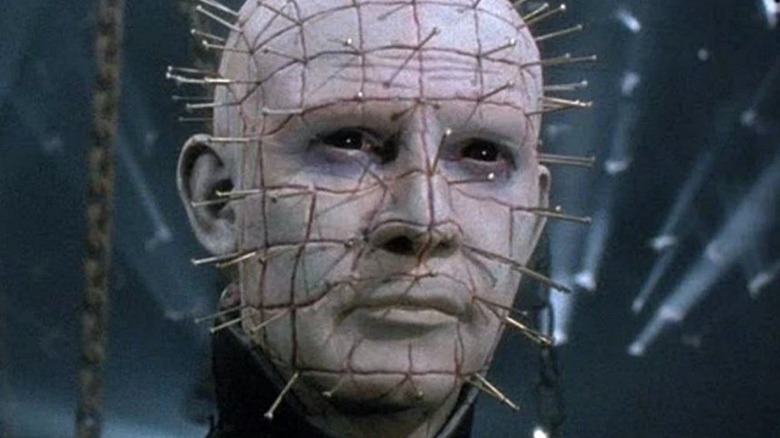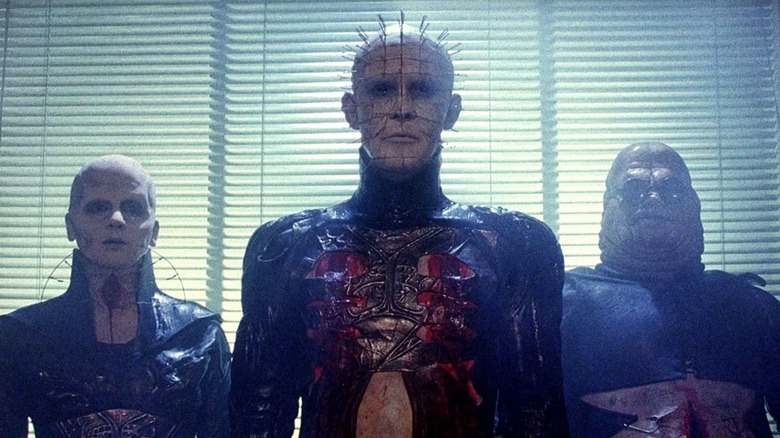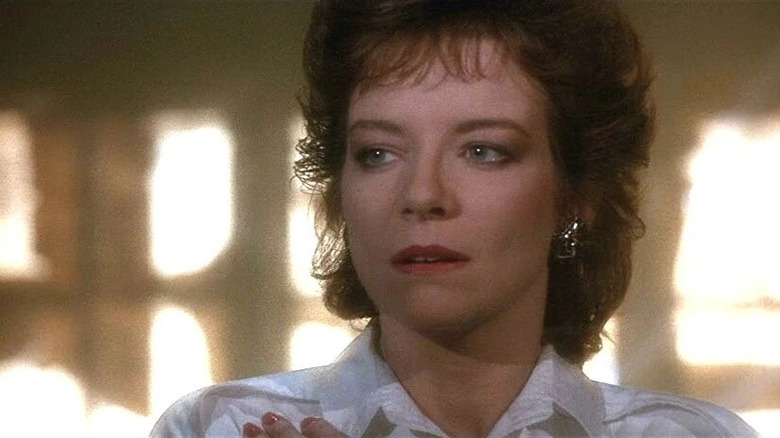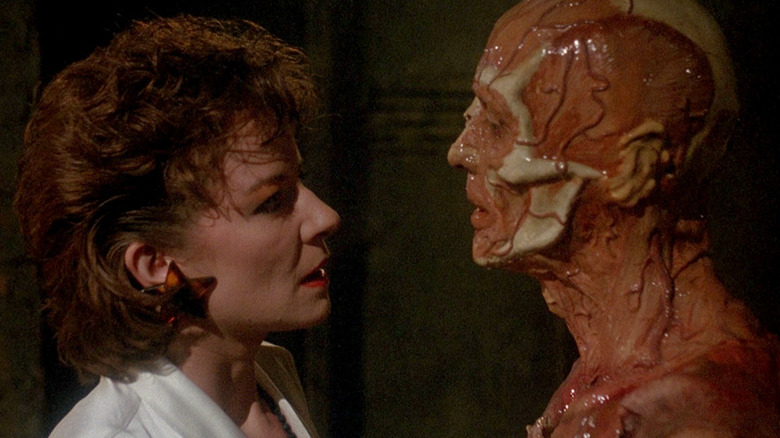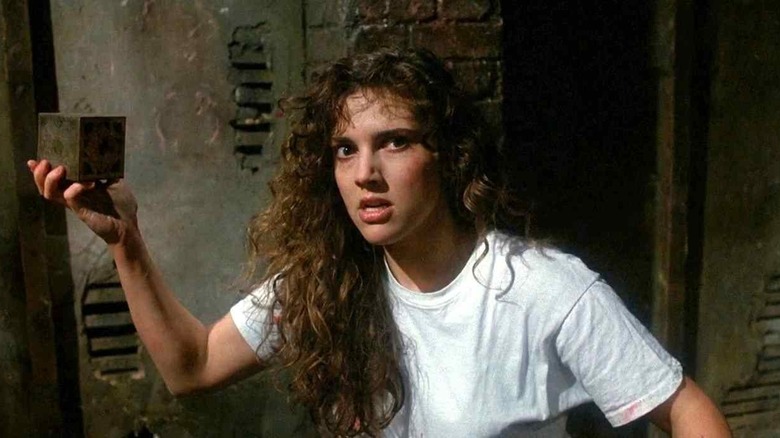The Real Reason Hellraiser Still Makes Us Bleed After 35 Years Of Beautiful Suffering
It's been 35 years since "Hellraiser" first sunk its hooks and chains into popular culture, and the suffering has been legendary ever since. The world of scary cinema has evolved quite significantly in that time, but "Hellraiser" remains a labyrinth unto itself. When Pinhead said he had such sights to show us, he wasn't lying.
Clive Barker's directorial debut hit theaters during the Golden Age of slasher films, but "Hellraiser" had no interest in being another horror flick about masked killers hacking and slashing their way through unsuspecting teenagers. "Hellraiser" had more horrific and complex ideas on its mind from the get-go, mixing demons, eroticism, mysticism, domestic drama, and twisted romance to tell a unique story about a dysfunctional family.
Fast forward to the year 2022 and "Hellraiser" is the latest horror classic to be given the reboot treatment — which was arguably long overdue as the "Hellraiser" franchise needed an update. Still, while the newest incarnation of "Hellraiser" is successful in its own right, it also reminds viewers that the original exists and that it's still a powerful piece of deliciously debaucherous filmmaking. But what makes "Hellraiser" hold up after all these years?
Pinhead is a sophisticated monster
No monster movie is complete without, well, the monster. Fortunately, "Hellraiser" has a strong roster of nightmare-inducing demons in the form of the Cenobites — leather-clad monstrosities who are summoned to the realm of the living through a mysterious puzzle box. Of course, their leader, Pinhead (Doug Bradley), needs no introduction as he's a bonafide horror icon and unlike other horror villains.
Horror movies about monsters and killers typically present the foes as silent or prone to cheesy one-liners. Pinhead, meanwhile, is an articulate and intelligent demon whose mannerisms echo the perverse elegance of classic monsters such as Dracula. It'd be fun to play chess and discuss philosophy with him in a social setting. He interacts with his subjects, and Doug Bradley's sophisticated accent adds some class to the monster's aesthetic.
At the same time, Pinhead and his Cenobite minions aren't mindless slaughterers. Pinhead can be bargained with, and he only sets out to punish those who summon him — well, that was true until "Hellraiser III: Hell on Earth," which tore up the rulebook. While the silent and ruthless killers of other horror movies can be terrifying in their own right, the Hell Priest is intriguing as he's bound by rules and politics.
The human horror at the (hellbound) heart of Hellraiser
The best fantastical horror movies still manage to tap into everyday horrors that regular people can relate to. Clive Barker understood this when he created "Hellraiser," allowing him to successfully weave otherworldly elements with compelling human drama.
Julia (Clare Higgins) and Frank (Sean Chapman) are the real villains in "Hellraiser." Their passion-fueled — and utterly debaucherous — love affair drives them to commit murder, after all. Furthermore, they're willing to sacrifice their so-called loved ones in order to bring their nefarious plans to life. Julia spends most of the movie seducing men and beating them to death with a hammer. Frank consumes their flesh to sustain himself before stealing his brother's skin. Unlike the Cenobites, Julia and Frank are unrestrained, unbound by rules, and off the rails. The idea of people, who could be our neighbors, harboring dangerous secrets is truly disturbing.
However, when the demons, homicides, and cannibalism are removed from the equation, "Hellraiser" is a story about human beings at their most selfish and wicked. According to actor Andrew Robinson (per The Clive Barker Archives), the story is a metaphor for people running away from their problems — until the past literally comes back to haunt them. Even folks who haven't engaged in the aforementioned atrocities can relate to selfishness and avoiding their troubles to some degree. And this is why "Hellraiser" boasts the timeless quality of tapping into our primal fears and preying on our insecurities.
Hellraiser challenges attitudes toward sex
The slasher films of the 1980s were known for their titillation, but many of them boasted conservative attitudes in regard to sex. The virgin of the gang was always the survivor. Getting jiggy with it was a guaranteed death sentence for everyone involved. Whether or not movies of this ilk were trying to make a statement is up for debate, but "Hellraiser" rejected the trend.
While the movie explores the dark side of carnal activities, it understands that sex is complex and can be used to great dramatic effect. Barker once noted that there's a "theme of rampant passion and uncontrollable desire going through my written work" and his goal with "Hellraiser" was to apply these sensibilities to film (via The Clive Barker Archives). He's always been interested in exploring the ambiguities of sexuality and looking at the most radical elements of the carnal deed. Additionally, he believes that sexuality can lead to interesting drama. "Hellraiser" allowed him to push boundaries, enter forbidden zones, and challenge societal norms pertaining to sex, which he's admitted are some of his favorite things to do as an artist (per Clive Barker).
From the S&M imagery of the Cenobites to Frank's quest for unknown pleasure, "Hellraiser" is loaded with sexual symbolism and metaphors that don't align with traditional attitudes. In many ways, horror cinema is still trying to catch up with "Hellraiser" as its sexual ideas are presented so imaginatively and boldly.
Hellraiser is steeped in lore
"Hellraiser" is a lowkey movie that takes place in an isolated house for most of its running time. Yet, the film feels grandiose and elevated due to the lore that Clive Barker created for the proceedings. The story has roots in supernatural literature and mythology, but it reimagines age-old concepts to great effect.
Up first is the Faustian pact. Like that legend, summoning the Cenobites is akin to making a deal with the Devil in exchange for unknown knowledge. Unfortunately, damnation is the final destination for those who are foolish enough to call upon the demons because they crave the ultimate pleasures. Similarly, the device used to summon the creatures is reminiscent of Pandora's Box as both are associated with evil and temptation.
It's also worth noting that the Cenobites only appear for a few minutes in "Hellraiser," but their brief cameos make the film feel expansive. You don't need to learn their backstory to know that they're arcane beings who come from an unknown universe and have caused havoc throughout history. Some of the "Hellraiser" sequels and other media delve deeper into their world, but the power of the first film stems from giving viewers a brief glimpse into a horrific realm that exists beyond our own. Sometimes, that's better than being shown all of the sights.
